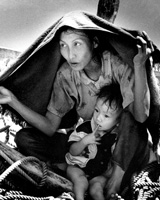
The year 2012 marked the 50th anniversary of U.S. involvement in Vietnam. Military advisers were first sent in 1959, but it was in 1962 that the Pentagon authorized a Vietnam Service Ribbon for troops sent to Southeast Asia.
The rationale for fighting was the domino theory, the belief that if Vietnam fell to communism, the rest of Southeast Asia—Thailand, Cambodia, Laos—would follow. Originated by columnist Joseph Alsop, the metaphor was used by President Dwight D. Eisenhower in 1954 to justify economic aid to the South Vietnamese government. Antiwar activists such as Norman Mailer frequently challenged the idea.
In 1969, facing a growing antiwar movement and demonstrations, President Richard Nixon called on support from the silent majority, a term he applied to advocates of the war who were not vocal. Critics used the term credibility gap, coined during the Cuban Missile Crisis, to refer to the perceived disparity between government statements and the truth. In South Vietnam some American GIs wore buttons that read, “Ambushed at Credibility Gap.” Postwar cynicism about the costly, prolonged American involvement in Vietnam came to be called Vietnam syndrome, a term reappearing in 1991 during the Persian Gulf crisis.
On the battlefield, doubt and dislike of authority sometimes took the violent form of fragging. Derived from the abbreviation of “fragmentation grenade,” this expression was used for wounding or killing one’s superior officer, the grenade often being the weapon of choice. Of course such an action made it important to cover your ass (CYA), a term that acquired considerable popularity during the war. Contempt for enlisted men and officers who were assigned to noncombat stations and rarely left base camp was expressed in the acronym REMFs, for “rear-echelon motherfuckers.”
In country was the name given to Vietnam during U.S. operations there. For many grunts, as infantrymen came to be called, the conditions were difficult to endure. According to one authority, “grunt” allegedly referred to an infantryman’s inarticulateness, but the more common view is that it is the sound he made while carrying his heavy pack, weapon, ammunition, and rations. Another name for ground infantry was legs, referring to their mode of transportation. They were also called boonie rats, “boonies” meaning “out in the field,” derived from the earlier nickname for the jungle, “the boondocks.”
To hump meant to march, especially under the weight of heavy equipment. An ammo humper was any grunt carrying ammunition. In addition, infantrymen carried a bum’s roll, a light pack resembling a hobo’s and containing fatigues, dry socks, and a jungle blanket. They wore jungle boots, first developed for use in the South Pacific during World War II, which looked like a combination of combat boots and canvas sneakers. Unlike leather boots, these didn’t rot in the dampness of tropical Vietnam and dried more readily after crossing streams or rice paddies. Marching distances were measured in kilometers, dubbed klicks or clicks, after the mid-1950s when the army began using the metric system for all maps and fire-control systems.
Naturally, not everything went well. Mass confusion was termed a cluster fuck; an even more extreme version, originating with similar terms in World War II but widely used in Vietnam, was FUBAR (fucked up beyond all recognition).
There were many terms for killing. To blow away later became a common civilian idiom. Others were to dust, grease, pop (also meaning to shoot), use up, wax, waste, and zap. Some operations aimed to kill a maximum number of enemy soldiers and then give up the ground. These were called search-and-destroy missions, or S&Ds. A version of this was called a thunder run, in which a column of armored vehicles moved along a trail, firing alternately left and right. A reconnaissance mission was known as a snoop ’n’ poop, its purpose to find and observe the enemy and report back. An extremely dangerous mission was that of the tunnel rat, a soldier who searched the Vietcong’s labyrinthine underground complexes, often with not much more equipment than a flashlight and a .45-caliber pistol.
A field phone lineman was similarly called a wire rat, and his communications network, either telephone or radio wire, was called the loop. Today, being in or out of the loop denotes whether someone is part of a particular decision-making process or has access to certain information.
After the U.S. withdrawal in 1975, hundreds of thousands of Vietnamese fled the communist regime, which imprisoned and punished its former opponents. Many left the country in boats that were inadequate for transport on the open seas; these boat people often died of hunger, thirst, disease, or attacks by pirates. Survivors frequently ended up in refugee camps, and several hundred thousand were eventually resettled in other countries.
Christine Ammer has written dozens of wordbooks, including Facts on File Dictionary of Clichés, 3rd edition.





